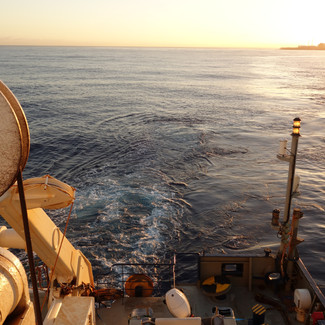OPERATION – Echo-sounders calibration
- by Florence Galletti IRD - Researcher in public
- 26 avr. 2017
- 3 min de lecture
The first operation of the cruise took place in the Bay of St Paul, Reunion island, France on Monday 24rd and Tuesday 25th of April. The “pelagic” team had first to run the calibration of the five acoustic probes positioned under the ship’s hull.
This does not come as a surprise that this operation is run first. Acoustic calibrations are always performed ahead of the cruise and sampling. This encompasses the standardization of the echo-sounder using a specific item with known characteristics, here we used a tungsten ball. The echo-sounder first emits a sound wave, and then the ball sends the signal back to the 5 probes indicating its depth, its position inside the acoustic cone, and the signal strength. This is the method performed to obtain an individual acoustic answer from the sphere, contributing to the calibrating of the overall system.
If one knows the sounders used to draw the bathymetry of the ocean, here we are using different ones. Our acoustic sounder is a EK80 and has a clear role in giving information on the biology component structure (i.e. detection, identification, geolocalisation) and size (i.e. biomass, size of shoals). It can be used to observe diel vertical migration (vertical migration at dawn and dusk) of live organisms through the water column. Our echo-sounder is echo friendly as the strength of the emitted signal has a very low impact on the marine life.
The leaders of this operation are Pascal Cotel and Jean-Francois Ternon (IRD), helped by Adrien Berne (ENSTA Bretagne), as well as several specialized crew members from IPEV, such as Helene Leau, in charge of the scientific operations on board the Marion Dufresne.
Run as a team between the bridge and the scientific platform, only a few equipment is needed: five probes which different frequency 18, 38, 70, 120, 200kHz located under the hull of the Marion Dufresne, a calibration ball made of tungsten with a diameter of 38.1 mm that hang at the end of a thread, three fishing rods mounted with reels and three threads each 0.39mm thick, those items making a triangle under the ship. This operation requires specific expertise and a load of patience to roll down the ball and to place it perfectly under each sounder.
Started at 8:00 am and after some struggling due to currents and tide (i.e. a ball that does not reach the right spot under the boat to properly interact with the transducers, a thread that breaks, a rotation in the crew). Finally, the use of the rubber boat allowed the proper positioning of the ball with one of the thread following the passage way from the aft. At 15:00, two frequencies out of five are already calibrated by activating successively the sounder 18 and 38kHz, which will allow to detect the organisms located the deepest in the water column (~2000m). The three other frequencies 70, 120 and 200kHz are done a lot faster then. These ones will detect smaller and finer items at shallower depths (i.e. 200kHz for 150m). It is worst noting that frequencies can be adjusted as will depending on the target.
For sites that are deep or hard to reach, where visual observation by human is not possible, the use of the acoustic eye, it behaves more like an eye than an ear, comes without doubt. The use of acoustic in marine biology has become a real advantage in compliment with more traditional techniques (i.e. trawls, direct visual observations) to describe marine life. For this expedition, it is a unique addition to the analysis of organisms’ communities along the seamount and to the understanding of their displacement and behaviour dynamics.
The five echo-sounders will be running through the whole journey to the Walters shoal...























Commentaires